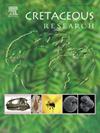Coupled U–Pb and Lu–Hf zircon data of the marine Pilmatué Member, Agrio Formation: Implications for sedimentary provenance and source areas across the Early Cretaceous in the Neuquén Basin, Argentina
IF 1.7
3区 地球科学
Q1 GEOLOGY
引用次数: 0
Abstract
The Lower Cretaceous Neuquén Basin is characterized by an almost complete stratigraphic record with marine and continental successions that have been addressed from the perspective of compositional and provenance analyses. However, determination of source areas through geological time is still a matter of debate. This work focuses in the upper Valanginian–lower Hauterivian Pilmatué Member (Agrio Formation of the Mendoza Group), a marine unit that represents shallow to offshore settings mainly composed of mudstones. In order to study the provenance and source areas, outcrop samples were examined through petrography, X-ray diffraction, and U–Pb/Lu–Hf zircon analyses. Sandstone deposits are scarce in the unit and show high compositional maturity related to fine-grained sediments preserved during transport until their final deposition. In the Pilmatué Member, the clay fraction is dominated by detrital illite and chlorite derived from the erosion of plutonic/metasedimentary basement rocks likely subjected to arid–semi-arid climate in the hinterland. Four main U–Pb age populations were determined: (1) Mesoproterozoic–Neoproterozoic, (2) Cambrian–Ordovician, (3) Permian–Triassic, and (4) Early–Middle Jurassic, which indicate an important denudation of old igneous-metamorphic basement rocks not recorded in the underlying Upper Jurassic and Lower Cretaceous units. A detailed compilation of the limited U–Pb/Lu–Hf zircon data from Upper Jurassic and Lower Cretaceous units reinforce the ideas that hinterland source regions located adjacent to the basin boundaries were the main source of clastic detritus. Since U–Pb ages show little variations across late Valanginian–Albian times, sediment transfer zones seem to have been stable during the closure of the back-arc basin stage.
阿根廷neuqu 盆地Agrio组海相pilmatu段U-Pb和Lu-Hf锆石资料对早白垩世沉积物源和源区的指示
下白垩统neuqun盆地具有几乎完整的海相和陆相地层记录,并对其进行了成分分析和物源分析。然而,通过地质年代确定源区仍然是一个有争议的问题。这项工作的重点是上valanginia -下Hauterivian pilmatu段(Mendoza Group的Agrio组),这是一个海洋单元,代表了主要由泥岩组成的浅海环境。通过岩石学、x射线衍射、U-Pb / Lu-Hf锆石分析等方法,对露头样品进行了物源区研究。单元内砂岩矿床较少,其成分成熟度较高,与运输过程中保存的细粒沉积物有关,直至最终沉积。在pilmatu段,粘土组分以碎屑伊利石和绿泥石为主,这些碎屑伊利石和绿泥石来自深部/变质沉积基底岩的侵蚀,可能受到内陆干旱-半干旱气候的影响。确定了4个主要的U-Pb年龄群:(1)中元古代-新元古代、(2)寒武系-奥陶系、(3)二叠系-三叠系和(4)早-中侏罗统,这些年龄群表明下伏的上侏罗统和下白垩统单元中没有记录的古老火成岩-变质基底岩发生了重要的剥蚀作用。通过对上侏罗统和下白垩统有限U-Pb / Lu-Hf锆石资料的详细整理,证实了靠近盆地边界的腹地源区是碎屑岩主要来源的观点。由于U-Pb年龄在晚瓦兰吉尼亚-阿尔比安时期变化不大,沉积物转移带在弧后盆地闭合阶段似乎是稳定的。
本文章由计算机程序翻译,如有差异,请以英文原文为准。
求助全文
约1分钟内获得全文
求助全文
来源期刊

Cretaceous Research
地学-地质学
CiteScore
4.10
自引率
19.00%
发文量
235
审稿时长
12 weeks
期刊介绍:
Cretaceous Research provides a forum for the rapid publication of research on all aspects of the Cretaceous Period, including its boundaries with the Jurassic and Palaeogene. Authoritative papers reporting detailed investigations of Cretaceous stratigraphy and palaeontology, studies of regional geology, and reviews of recently published books are complemented by short communications of significant new findings.
Papers submitted to Cretaceous Research should place the research in a broad context, with emphasis placed towards our better understanding of the Cretaceous, that are therefore of interest to the diverse, international readership of the journal. Full length papers that focus solely on a local theme or area will not be accepted for publication; authors of short communications are encouraged to discuss how their findings are of relevance to the Cretaceous on a broad scale.
Research Areas include:
• Regional geology
• Stratigraphy and palaeontology
• Palaeobiology
• Palaeobiogeography
• Palaeoceanography
• Palaeoclimatology
• Evolutionary Palaeoecology
• Geochronology
• Global events.
 求助内容:
求助内容: 应助结果提醒方式:
应助结果提醒方式:


